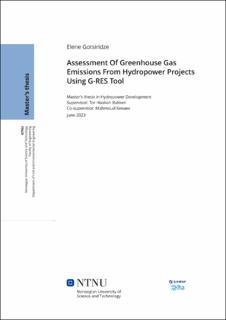| dc.description.abstract | 2050 net zero transition requires analyzing and calculating GHG emissions from different renewable energy sources. Hydropower in this big transition plays a vital role, as it serves as a green battery capable of generating electricity when other renewables like wind and solar may be hindered by weather conditions. Energy storage, provided by hydropower, becomes essential in such scenarios.
Although hydropower is a renewable energy source, which has a minimum emission, it still produces GHG emissions from reservoirs and during construction, hence, it is important to calculate GHG emissions related to hydropower projects.
In this study, the focus is on evaluating emissions from existing or expanded reservoirs, excluding emissions from the construction phase.
To study and analyze GHG emissions from reservoirs G-RES tool was used, which is led by International Hydropower Association and the UNESCO Chair in Global Environmental Change, The G-res Tool was developed using a conceptual framework created with scientists from the University of Quebec at Montreal (UQAM), the Norwegian Foundation for Scientific and Industrial Research (SINTEF) and the Natural Resources Institute of Finland (LUKE), with assistance from the World Bank. The study utilized the G-RES tool to investigate 15 Norwegian reservoirs, comparing the results with emissions from eight Norwegian wind farms and the global solar project emissions intensity.
The simulations conducted highlighted the importance of factors such as land cover and soil type within reservoirs, as they significantly impact the quantity of emissions released into the atmosphere. Thoroughly studying these factors before embarking on reservoir construction is crucial.
The study showed that the lowest emissions intensity from reservoirs can be 0gCO2e/kWh, while the highest is 5.7gCO2e/kWh, in a comparison from Norwegian onshore wind the lowest emissions rate is 11gCO2e/kWh, and from the offshore wind concepts the lowest 18 gCO2e/kWh, and the highest 31.4gCO2e/kWh, while the lowest global solar emissions rate is 38gCO2e/kWh, while the highest is 48gCO2e/kWh.
Further examination and improvement of the G-RES tool are necessary, to ensure that all requirements are met. The proper utilization of this tool can save considerable time, expenses, and resources, enabling hydropower project owners to attain certification and generate green electricity.
The study is done with SINTEF and IHA (International Hydropower Association) collaboration | |
